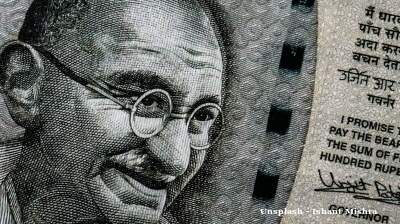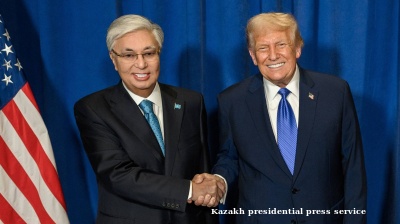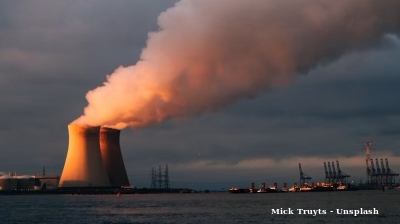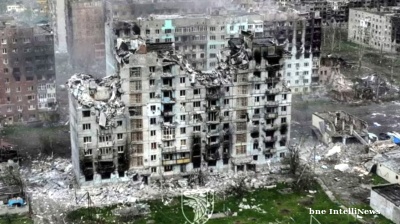The collapse of oil prices at the start of March after Russia withdrew from the OPEC+ deal was a disaster for Russia, which remains heavily reliant on oil exports to fund the budget. But an odd thing then happened: the price of oil has lost 56% of its value YTD as of May 7, but the ruble is only down by 19% over the same period.
Like some Tibetan monetary monk, the ruble’s value has managed to levitate and stay up even as the oil price ground fell away from underneath it.
The ruble’s value has long been tied to the price of oil and the two used to move in lock step. That changed when the Ministry of Finance introduced the so-called budget rule (aka the financial rule) that automatically siphons off any excess oil export revenue to the National Welfare Fund (NWF) for all revenues earned from oil prices over $42.
That rule led to the build up of the reserve fund which held RUB12 trillion ($163.4bn), or 11% of GDP as of April 1, and helped bring down inflation to post-Soviet lows, but most importantly largely broke the tie between the ruble’s value and the price of oil.
That has changed now. Since oil prices have fallen below the key $42 for a cost of a barrel of oil threshold, the budget rule doesn't make any difference any more; oil prices and the value of the ruble should re-engage.
The average value of the ruble in 2018 was RUB62.7 to the dollar, while the average price of oil was $70.8. In 2019 the price of oil fell 11.4% to $62.7, while the value of the ruble fell by less, down only 3.2% to RUB64.7 largely thanks to the steading effect of the budget rule.
But the changes in the first four months of 2020 have been a lot more dramatic. The average price of oil has shrunk by a third (31.2%) to $43.1 over the first four months – including January and February when oil prices were $63.7 and $55.7 respectively— whereas the average value of the ruble over this period was RUB68.7 to the dollar, down by only 6%.
Even in March and April, the epicentre of the crisis, the average cost of oil dropped to $32 and then $21.2 respectively, or by another quarter (25.8%) followed by another collapse by a third (33.6%) the following month, but the value of the ruble in those two months was RUB73.7 and RUB75.2, down by 7.3% in March and a mere 1.9% in April.
That is not to say the ruble has not been battered by the current crisis, considered to be the worst since the 1998 total meltdown of Russia’s financial system, as the chart of the weekly exchange rates of ruble vs dollar shows. But how can the value of the ruble in Russia’s petro-dependent economy defy gravity so easily?
CBR to the rescue
One of the reasons why Russia is expected to weather this crisis a lot better than many of its emerging markets (EM) peers is Central Bank of Russia (CBR) governor Elvira Nabiullina allowed the ruble to float freely as part of her response to the 2014 oil shock, when oil prices collapsed the last time.
As bne IntelliNews has argued elsewhere, the Kremlin is fixated on preserving Russia’s foreign exchange reserves, which totalled $569.7bn as of April 1, as it regards them as a strategic asset: the size of Russia’s reserves means it is impervious to sanctions, as it can simply buy its way out of trouble if the US imposes harsh sanctions, without the need to borrow on the international capital markets that would make it vulnerable to sanction pressure.
The CBR has shown that it is prepared to allow the exchange rate to take the brunt of the oil shock in order to preserve those reserves and has not been defending the ruble, unlike many countries, Turkey notable among them, that have also seen their currencies collapse. Moreover, the money in the National Welfare Fund (NWF) also won’t be used to defend the ruble, as that money is solely tasked with supporting the budget and covering the RUB3-4 trillion federal budget deficit that is expected this year.
During the 2014 oil price shock the ruble also tanked, and by a lot more. Before that crisis the ruble had been trading at about RUB35 to the dollar for several years but suddenly dropped to a nadir of circa RUB80 to the dollar.
Investors freaked out and called Nabiullina reckless and incompetent, but then, as now, she refused to burn through Russia’s reserves to defend an undefendable exchange rate.
That crisis started in October and peaked in December, when the CBR finally imposed a 17% emergence rate hike on December 16, 2014 to put a floor under the collapse of the currency.
The ruble has lost a lot less value than it did in those few months in 2014, which has meant both the investors and the population have greeted this crisis with a lot more calm than in 2014. And it also means the economic damage done by this crisis – as far as currency effects are concerned – is mild by comparison.
Amazingly, unlike 2014 when the CBR made the biggest one-off rate hike in Russian history, the CBR actually cut rates by an aggressive 50bp at its last policy meeting in April to 5.5% in an effort to give the economy a growth-boosting shot in the arm.
April’s cut in rates is an entirely different mind-set. Usually during a crisis emerging market central banks are forced to hike rates to protect the currency, as Russia did in 2014, whereas developed market economies cut them to boost growth. And indeed, the first thing the US Federal Reserve bank did in April was cut US interest rates to zero.
Nabiullina had a difficult choice in April, as she could have gone both ways: cut rates to boost growth, or hike rates to head off inflation caused by the devaluation of the ruble. But it is a testimony to the effective management of Russia’s central bank since she took over in 2013 that she had a choice and ended up choosing the developed market’s response to a nasty external shock.
Defending the ruble
The CBR abandoned the “ruble exchange rate corridor” at the end of 2014, a mechanism that previously had been place for almost two decades that obliged the CBR to manage the value of the ruble’s value and stop rapid devaluations.
Russia’s reserves have fallen this year from a peak of just over $580bn to just under $570bn as of the start of April, but most of that fall is due to FX revaluation effects of the assets the CBR uses to hold Russia’s reserves. The CBR has spent a mere circa $2bn of actual cash in the last month in money market interventions to smooth out the fall in the ruble’s value, which is very little.
Indeed, astonishingly Russia’s reserves have actually increased this year by just over $7bn from $562.3bn it had as of January 1. The reserves fell slightly from $570.3bn in February to $563.4bn in March, but amazingly then grew again in April to the current $569.7bn.
The CBR will not touch Russia’s foreign exchange reserves to defend the value of the ruble and it can’t use the money in the NWF either, which technically belong to the Ministry of Finance. However, the government has come up with a dodge to make more dollars available to the CBR that can be used to defend the ruble, which explains its gravity-defying performance over the last two months.
On April 11 the CBR rushed through a deal to sell its 50%+1 stake in the state-owned retail banking giant Sberbank to the Ministry of Finance for RUB2.14 trillion ($29.1bn).
The change of ownership solves several problems in one go. First is that the central bank was in the uncomfortable position of both being the banking sector regulator and owning by far the largest bank in the sector. Now that bank is owned by the Ministry of Finance, which is how it should be.
Second is that the deal will put more money into the budget. Sberbank is the most profitable bank in the sector and recently promised to increase its dividend payments to 50% of its income as the government increasingly uses dividends to tap the profits of its best companies, rather than taxes. However, the CBR regularly held back part of those payments to keep on its own balance sheet. Now all of Sberbank’s dividends will be paid directly into the budget.
Thirdly, the deal in effect provides a back door route for the CBR to tap the NWF and gives it cash to spend in the money markets to defend the ruble. The Ministry of Finance paid for the deal using NWF money, which has now dropped to about RUB9 trillion.
This last point is key, as the CBR’s alternative to holding the ruble’s value up was to hike rates again, which would have killed off whatever growth the Russian economy is due to put in during its recovery from April’s crash.
Just how the CBR will use this money remains unclear, but the $29bn it now has is thought to be enough to defend the ruble until September, by which time the government hopes the situation will have stabalised and oil prices will have recovered enough to take the pressure off the government’s finances, especially after the OPEC++ production cut deal that will reduce production of oil by 9.7mn barrels per day that was signed on April 13.
“The CBR will be gradually selling [the $29bn] until the end of September so far as the price of Urals stays below $25 a barrel,” Ivan Tkachev, the economics editor of RBC, said in a recent article. “Since the onset of these interventions, the [Russian benchmark blend] Urals price has never exceeded the threshold, and the CBR sold more than $2bn in April. The more Russian oil deviate from $25, the higher the amount of currency sold by the CBR. Thus the central bank is effectively compensating for the shortfall of export earnings, supplying the domestic market with that amount of currency as if the Urals price was $25.”
The CBR’s currency sales will automatically protect the ruble from depreciating too much while oil prices stay low, and buys the government five months of time for the worst effects of the crisis to fade.
At $25 per barrel, the estimated fair value of the ruble is RUB75-76 to the dollar, estimates Tkachev. The price of Brent was $30.97 as of May 9 and the value of the ruble was RUB73.4, slightly better than Tkachev’s lower band estimate of oil and exchange rate forecasts.
And the Sberbank money is not the only resource that the government has brought to the ruble’s defence. In addition to the CBR’s own operations, the Ministry of Finance also sells currency on the money markets. The CBR’s statistics aggregate data on both mechanisms, since it is the CBR that is the currency sales agent in both cases, says Tkachev.
“Unlike the CBR’s variable sales, the Finance Ministry’s operations are fixed one month in advance. In April, its daily foreign currency sales amount to the equivalent of RUB3.5bn (circa $46mn). But from March 10, when the CBR launched currency interventions on behalf of the Ministry of Finance, until April 22, more than $5bn was sold using both channels,” says Tkachev.
The sale of dollars under the fiscal rule are not happening as oil prices are under the key $42 per barrel level. However, on May 8 the CBR formalised an informal “auxiliary fiscal rule.” The CBR announced that it will intervene in the FX markets when the Russia’s Urals blend of oil prices (which usually cost about $2 less than Brent) drops below $25. That means the CBR will sell an additional $0.5-1.5bn on the open market for every $5/bbl decline in the Urals oil price below the lower threshold, analysts at VTB Capital estimate.
“That is the main reason the ruble has not followed oil prices down in their dramatic plunge,” says Tkachev.
Features

Indian bank deposits to grow steadily in FY26 amid liquidity boost
Deposit growth at Indian banks is projected to remain adequate in FY2025-26, supported by an improved liquidity environment and regulatory measures that are expected to sustain credit expansion of 11–12%

What Central Asia wants out of the upcoming Washington summit
Clarity on critical minerals and a lot else.

Global leaders gather in Gyeongju to shape APEC cooperation
Global leaders are arriving in Gyeongju, the cultural hub of North Gyeongsang Province, as South Korea hosts the Asia Pacific Economic Cooperation summit. Delegates from 21 member economies are expected to discuss trade, technology and security.





